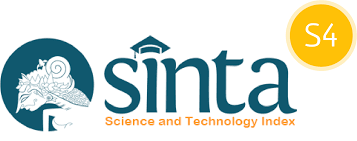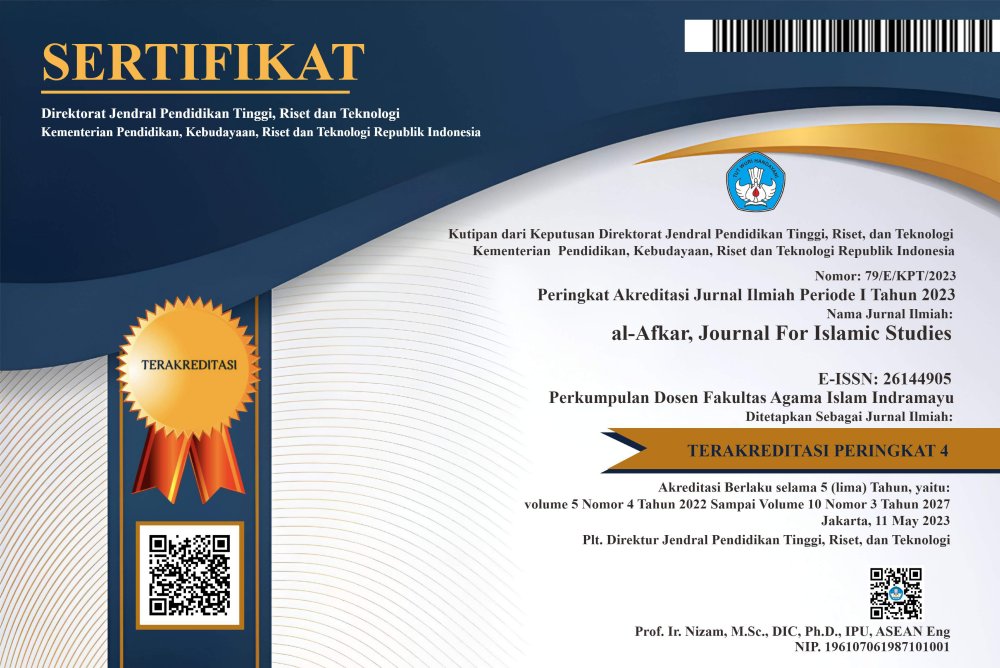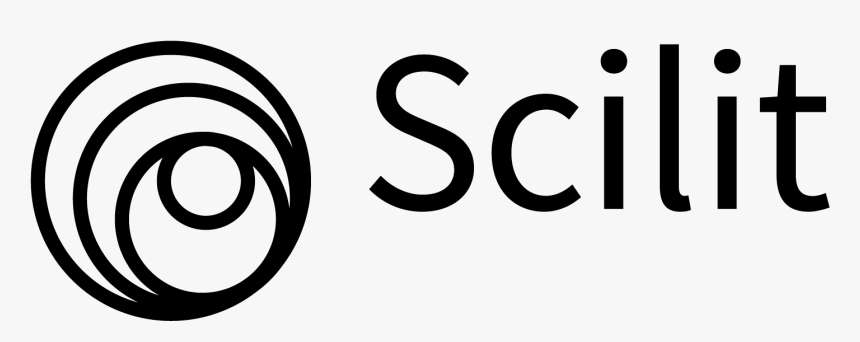Implementation of Active Learning Methods in Increasing Student Involvement in Islamic Religious Education Subjects
DOI:
https://doi.org/10.31943/afkarjournal.v7i4.1109Keywords:
Active Learning Methods, Students, Islamic EducationAbstract
In learning, there are components related to the learning process, one of which is the learning method. In connection with the learning process under study, it was found that so far the learning material at SMPN 2 Sintoga was taught through relatively conventional methods, so that the absorption of material for some students seemed monotonous and boring. This study aims to describe the learning methods applied at SMPN 2 Sintoga. The research method uses descriptive qualitative methods with primary data collection through interviews and observations As for secondary data obtained through documentation. The results showed that the application of active learning methods at SMPN 2 Sintoga was 100% unsuccessful, this was indicated by the results of observations and interviews with PAI teachers at SMPN 2 Sintoga. This is also influenced by 2 factors, namely supporting factors such as the existence of adequate learning facilities and resources, high student interest in learning, and the enthusiasm and professionalism of Islamic education teachers in guiding their students and inhibiting factors, namely the existence of some students who are still reluctant to express their opinions, and different student backgrounds. Active learning methods need to be improved so that students can be actively involved in learning activities.
Downloads
References
Afrinaldi, A. (2022). Overcoming Psychological Disorders Through Spiritual Guidance for Muslim Felons. Islam Transformatif: Journal of Islamic Studies, 6(2), 211–224.
Akhyar, M., Iswantir, M., & Gusli, R. A. (2023). IMPLEMENTASI PENDIDIKAN KARAKTER ANAK USIA DINI MELALUI PEMBELAJARAN AL-QUR’AN DI SD IT KARAKTER ANAK SHALEH KOTA PADANG. Jurnal Bilqolam Pendidikan Islam, 4(2), 31–46.
Ardita, S. (2022). PENERAPAN PENDEKATAN ACTIVE LEARNING PADA PEMBELAJARAN PENDIDIKAN KEWARGANEGARAAN MENGGUNAKAN METODE BERMAIN PERAN SERTA PERAN PENDIDIKAN KEWARGANEGARAAN SEBAGAI UPAYA MEMBENTUK KARAKTER SISWA KELAS VI DI SD NEGERI KANDANG MBELANG ACEH TENGGARA. (JKPD) Jurnal Kajian Pendidikan Dasar, 7(1), 16–27.
Dodik Kariadi, W. S. (2018). MODEL PEMBELAJARAN ACTIVE LEARNING DENGAN STRATEGI PENGAJUAN PERTANYAAN UNTUK. Jurnal EducatiO, 12(1), 1–10.
Fitri, A., Annas, F., Efriyanti, L., & Darmawati, G. (2023). Development of Instructional Media Using’Canva’Based on Animated Videos for the Subject of Biology. Jurnal Educative: Journal of Educational Studies, 8(1).
Hidayatul Mutmainah, S. A. (2021). Metode Pembelajaran Pendidikan Agama Islam Aktif dan Kreatif di Madrasah Aliyah Darul Ulum Banyuanyar Kecamatan Palengaan Kabupaten Pamekasan. Fikrotuna, 14(02), 2029–2045.
Homaedi, H., & Suhendi, R. (2018). Strategi Active Learning Dalam Pembelajaran Pai. Edupedia, 2(2), 23–31. https://doi.org/10.35316/edupedia.v2i2.327
Iswantir, I. (2017). Gagasan dan Pemikiran Serta Praksis Pendidikan Islam di Indonesia (Studi Pemikiran dan Praksis Pendidikan Islam Menurut Azyumardi Azra). Jurnal Educative: Journal of Educational Studies, 2(2), 165–177.
J, E. S. N. (2019). PENERAPAN METODE PEMBELAJARAN “ ACTIVE LEARNING- SMALL GROUP DISCUSSION ” DI PERGURUAN TINGGI SEBAGAI UPAYA PENINGKATAN PROSES PEMBELAJARAN. Fondatia: Jurnal Pendidikan Dasar, 3(2), 19–34.
Kasmawati, Suriyati, Diarti Andra Ningsih, & R. Nurhayati. (2022). Penerapan Metode Active Learning Dalam Meningkatkan Aktivitas Belajar Peserta Didik Pada Mata Pelajaran Pendidikan Agama Islam. Jurnal Al-Qalam: Jurnal Kajian Islam & Pendidikan, 14(1), 14–22. https://doi.org/10.47435/al-qalam.v14i1.801
Khusna, N. (2014). Penerapan Pendekatan Active Learning Melalui Strategi Pembelajaran Inkuiri Terhadap Pemahaman Konsep Peserta Didik Kelas VII SMP Islam Wonopringgo. Delta, 2(2), 51–56.
Kumara, A. (2004). MODEL PEMBELAJARAN “ ACTIVE LEARNING ” MATA PELAJARAN SAINS TINGKAT SD KOTA YOGYAKARTA SEBAGAI UPAYA PENINGKATAN “ LIFE SKILLS .” Jurnal Psikologi, 2, 63–91.
Martini, I. (2014). PENERAPAN ACTIVE LEARNING UNTUK MENINGKATKAN MINAT DAN HASIL BELAJAR APRESIASI MUSIK NUSANTARA PADA SISWA KELAS VIII A SMP NEGERI 7 PEMALANG. Jurnal Penelitian Pendidikan, 31(2), 117–122.
Muhasim, M. (2019). Pengaruh Metode Active Learning terhadap Peningkatan Motivasi dan Kreativitas Peserta Didik di Era Globalisasi. Palapa, 7(1), 108–130. https://doi.org/10.36088/palapa.v7i1.188
Mukhlison Effendi. (2013). Integrasi Pembelajaran Active Learning dan Internet-Based Learning dalam Meningkatkan Keaktifan dan Kreativitas Belajar. Jurnal Pendidikan Islam, 7(2), 283–308.
Nofrianti, Y., & Arifmiboy, A. (2021). Challenges and Problems of Learning Islamic Religious Education in the Digital Era. Islam Transformatif: Journal of Islamic Studies, 5(1), 34–45.
Nurrahmatika Mubayyinah, M. Y. A. (2017). Efektivitas Metode Active Learning dalam Meningkatkan Hasil Belajar Pendidikan Agama Islam Siswa Kelas X-A di SMA Darul Ulum 3 Peterongan Jombang. Jurnal Pendidikan Islam, 1(1), 75–93.
Patimah. (2019). PENGGUNAAN MODEL ACTIVE LEARNNG UNTUK MENINGKATKAN PRESTASI BELAJAR DALAM PEMBELAJARAN SEJARAH. INSPIRASI ; JURNAL ILMU-ILMU SOSIAL, 16(2), 151–163.
Sutinah, S. (2018). Implementasi Strategi Active Learning Dalam Pembelajaran Fiqh Siswa Madrasah Tsanawiyah Muhammadiyah Gedontengen Kota Yogyakarta. Al-Manar, 7(1), 1–38. https://doi.org/10.36668/jal.v7i1.71
Toha, S. M. (2018). PELAKSANAAN METODE ACTIVE LEARNING DALAM MENINGKATKAN HASIL BELAJAR SISWA PADA PEMBELAJARAN PENDIDIKAN AGAMA ISLAM. Ta’dibuna, 7(1), 79–93.
Zakir, S., Maiyana, E., & Jehwae, P. (2022). Improving Student Academic Performance Through Web Base Learning. Jurnal Educative: Journal of Educational Studies, 7(2), 173–184.
Zaman, B. (2020). PENERAPAN ACTIVE LEARNING DALAM PEMBELAJARAN PAI. Jurnal As-Salam, 4(1), 13–27.
Downloads
Published
How to Cite
Issue
Section
License
Copyright (c) 2024 Muaddyl Akhyar, Iswantir M, Salmi Wati

This work is licensed under a Creative Commons Attribution 4.0 International License.



















